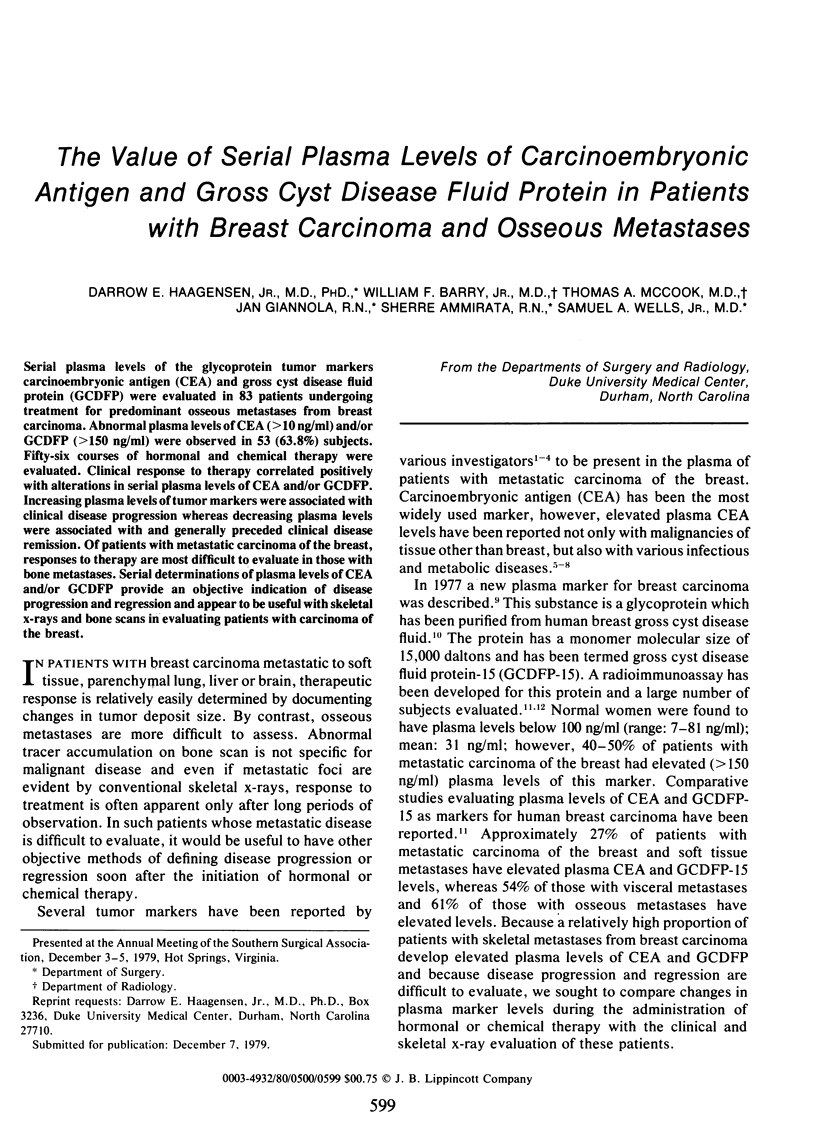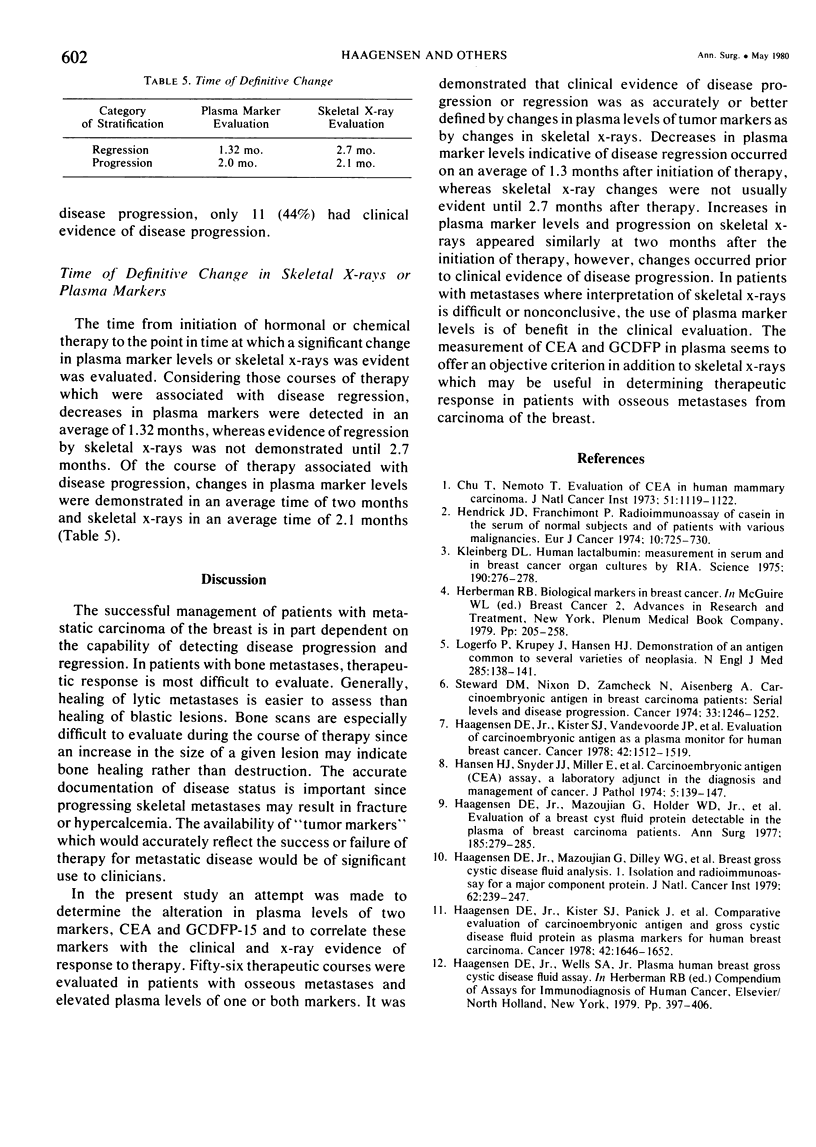Abstract
Serial plasma levels of the glucoprotein tumor markers carcinoembryonic antigen (CEA) and gross cyst disease fluid protein (GCDFP) were evaluated in 83 patients undergoing treatment for predominant osseous metastases from breast carcinoma. Abnormal plasma levels of CEA (greater than 10 ng/ml) and/or GCDFP (greater than 150 ng/ml) were observed in 53 (63.8%) subjects. Fifty-six courses of hormonal and chemical therapy were evaluated. Clinical response to therapy correlated positively with alterations in serial plasma levels of CEA and/or GCDFP. Increasing plasma levels of tumor markers were associated with clinical disease progression whereas decreasing plasma levels were associated with and generally preceded clinical disease remission. Of patients with metastatic carcinoma of the breast, responses to therapy are most difficult to evaluate in those with bone metastases. Serial determinations of plasma levels of CEA and/or GCDFP provide an objective indication of disease progression and regression and appear to be useful with skeletal x-rays and bone scans in evaluating patients with carcinoma of the breast.
Full text
PDF



Selected References
These references are in PubMed. This may not be the complete list of references from this article.
- Chu T. M., Nemoto T. Evaluation of carcinoembryonic antigen in human mammary carcinoma. J Natl Cancer Inst. 1973 Oct;51(4):1119–1122. doi: 10.1093/jnci/51.4.1119. [DOI] [PubMed] [Google Scholar]
- Haagensen D. E., Jr, Kister S. J., Panick J., Giannola J., Hansen H. J., Wells S. A., Jr Comparative evaluation of carcinoembryonic antigen and gross cystic disease fluid protein as plasma markers for human breast carcinoma. Cancer. 1978 Sep;42(3 Suppl):1646–1652. doi: 10.1002/1097-0142(197809)42:3+<1646::aid-cncr2820420844>3.0.co;2-n. [DOI] [PubMed] [Google Scholar]
- Haagensen D. E., Jr, Kister S. J., Vandevoorde J. P., Gates J. B., Smart E. K., Hansen H. J., Wells S. A., Jr Evaluation of carcinoembryonic antigen as a plasma monitor for human breast carcinoma. Cancer. 1978 Sep;42(3 Suppl):1512–1519. doi: 10.1002/1097-0142(197809)42:3+<1512::aid-cncr2820420824>3.0.co;2-6. [DOI] [PubMed] [Google Scholar]
- Haagensen D. E., Jr, Mazoujian G., Dilley W. G., Pedersen C. E., Kister S. J., Wells S. A., Jr Breast gross cystic disease fluid analysis. I. Isolation and radioimmunoassay for a major component protein. J Natl Cancer Inst. 1979 Feb;62(2):239–247. [PubMed] [Google Scholar]
- Haagensen D. E., Jr, Mazoujian G., Holder W. D., Jr, Kister S. J., Wells S. A., Jr Evaluation of a breast cyst fluid protein detectable in the plasma of breast carcinoma patients. Ann Surg. 1977 Mar;185(3):279–285. doi: 10.1097/00000658-197703000-00005. [DOI] [PMC free article] [PubMed] [Google Scholar]
- Hansen H. J., Snyder J. J., Miller E., Vandevoorde J. P., Miller O. N., Hines L. R., Burns J. J. Carcinoembryonic antigen (CEA) assay. A laboratory adjunct in the diagnosis and management of cancer. Hum Pathol. 1974 Mar;5(2):139–147. doi: 10.1016/s0046-8177(74)80061-4. [DOI] [PubMed] [Google Scholar]
- Hendrick J. C., Franchimont P. Radio-immunoassay of casein in the serum of normal subjects and of patients with various malignancies. Eur J Cancer. 1974 Nov;10(11):725–730. doi: 10.1016/0014-2964(74)90111-x. [DOI] [PubMed] [Google Scholar]
- Kleinberg D. L. Human alpha-lactalbumin: measurement in serum and in breast cancer organ cultures by radioimmunoassay. Science. 1975 Oct 17;190(4211):276–278. doi: 10.1126/science.1179206. [DOI] [PubMed] [Google Scholar]
- Steward A. M., Nixon D., Zamcheck N., Aisenberg A. Carcinoembryonic antigen in breast cancer patients: serum levels and disease progress. Cancer. 1974 May;33(5):1246–1252. doi: 10.1002/1097-0142(197405)33:5<1246::aid-cncr2820330509>3.0.co;2-o. [DOI] [PubMed] [Google Scholar]


